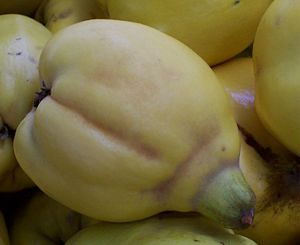Quince: Difference between revisions
imported>Martin Baldwin-Edwards (correction) |
imported>Martin Baldwin-Edwards mNo edit summary |
||
| Line 3: | Line 3: | ||
{{Image|QuinceLittePatch.jpg|right|300px|Quince, the fruit.{{QuinceLittePatch.jpg/credit}}}} | {{Image|QuinceLittePatch.jpg|right|300px|Quince, the fruit.{{QuinceLittePatch.jpg/credit}}}} | ||
The '''Quince''' is a small tree or shrub and sole member of the genus ''[[Cydonia]]'', family ''[[Rosaceae]]''; the name is also used for the fruit of the tree. Etymologically, the quince is the ‘fruit from Chaniá’, a port on the northwest coast of Crete from which quinces were exported. In ancient times Chaniá was known as Cydonia (in Greek κυδώνια), so the ancient Greeks called the fruit κυδώνιον μῆλον (‘Cydonian apple’). Its origins are unclear—putatively India or Persia—but by | The '''Quince''' is a small tree or shrub and sole member of the genus ''[[Cydonia]]'', family ''[[Rosaceae]]''; the name is also used for the fruit of the tree. Etymologically, the quince is the ‘fruit from Chaniá’, a port on the northwest coast of Crete from which quinces were exported. In ancient times Chaniá was known as Cydonia (in Greek κυδώνια), so the ancient Greeks called the fruit κυδώνιον μῆλον (‘Cydonian apple’). Its origins are unclear—putatively India or Persia—but by 700 BC it was being used by the Greeks as a ritual item in wedding ceremonies. | ||
Quinces are grown under similar conditions to [[Apple (fruit)|apple]] and [[pear]] trees, and are susceptible to many of the same diseases and pests, such as [[fire blight]] and [[scale insects]]. It is, however, widely used by commercial growers as a [[rootstock]] for grafts of apple and pear trees. | Quinces are grown under similar conditions to [[Apple (fruit)|apple]] and [[pear]] trees, and are susceptible to many of the same diseases and pests, such as [[fire blight]] and [[scale insects]]. It is, however, widely used by commercial growers as a [[rootstock]] for grafts of apple and pear trees. | ||
Being naturally high in [[pectin]], the fruit is used mainly for [[jelly|jellies]] and [[preserves]], but may also be eaten baked or prepared like other fruits. | Being naturally high in [[pectin]], the fruit is used mainly for [[jelly|jellies]] and [[preserves]], but may also be eaten baked or prepared like other fruits. | ||
Revision as of 09:16, 20 March 2011
The Quince is a small tree or shrub and sole member of the genus Cydonia, family Rosaceae; the name is also used for the fruit of the tree. Etymologically, the quince is the ‘fruit from Chaniá’, a port on the northwest coast of Crete from which quinces were exported. In ancient times Chaniá was known as Cydonia (in Greek κυδώνια), so the ancient Greeks called the fruit κυδώνιον μῆλον (‘Cydonian apple’). Its origins are unclear—putatively India or Persia—but by 700 BC it was being used by the Greeks as a ritual item in wedding ceremonies.
Quinces are grown under similar conditions to apple and pear trees, and are susceptible to many of the same diseases and pests, such as fire blight and scale insects. It is, however, widely used by commercial growers as a rootstock for grafts of apple and pear trees.
Being naturally high in pectin, the fruit is used mainly for jellies and preserves, but may also be eaten baked or prepared like other fruits.
